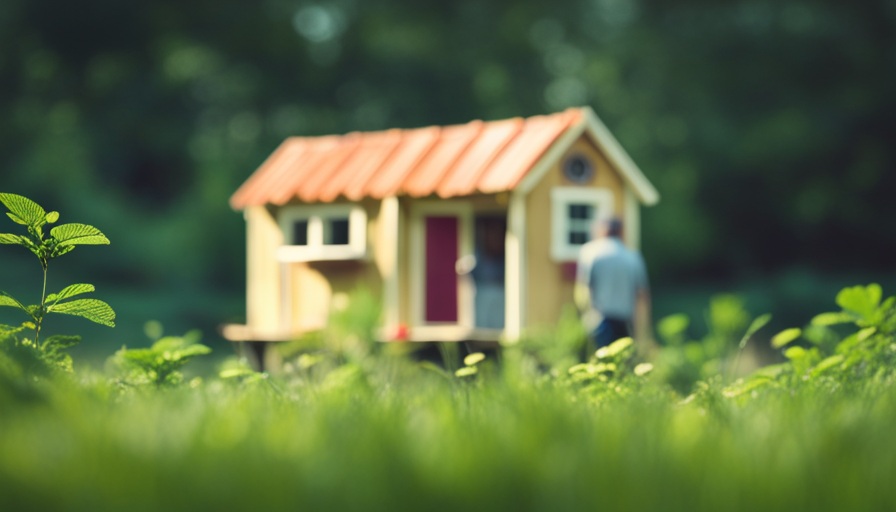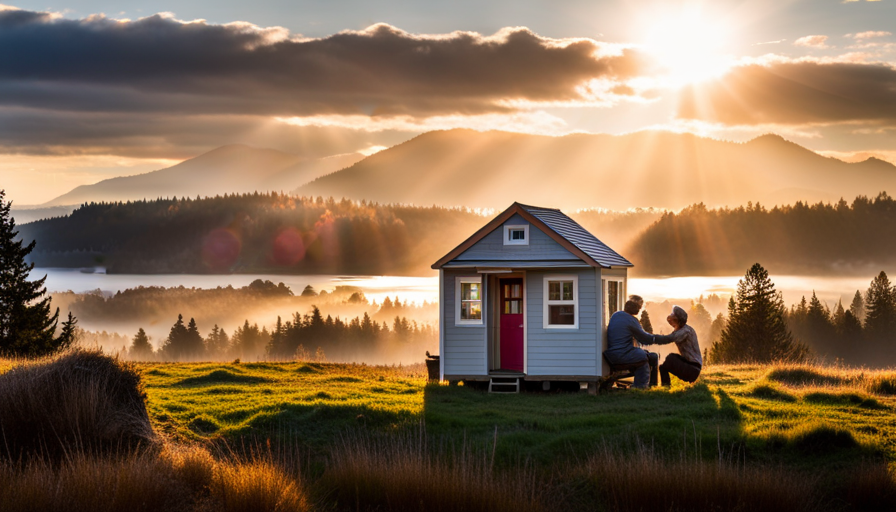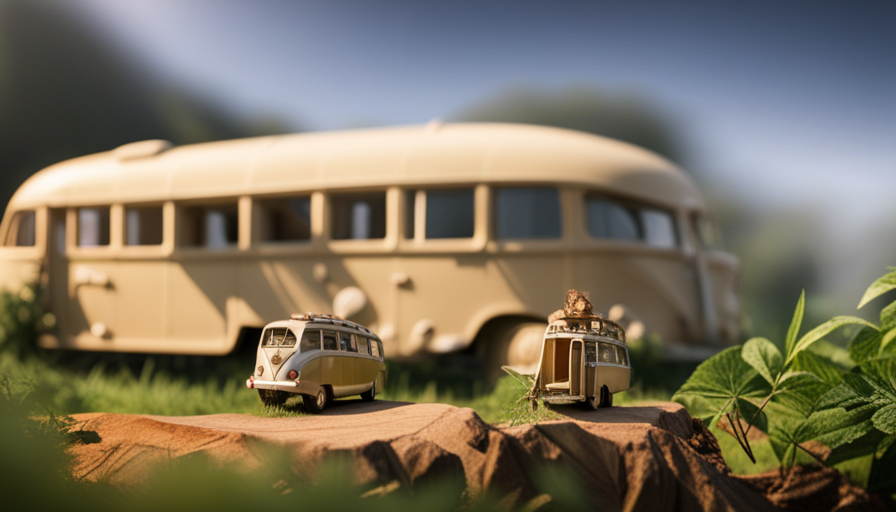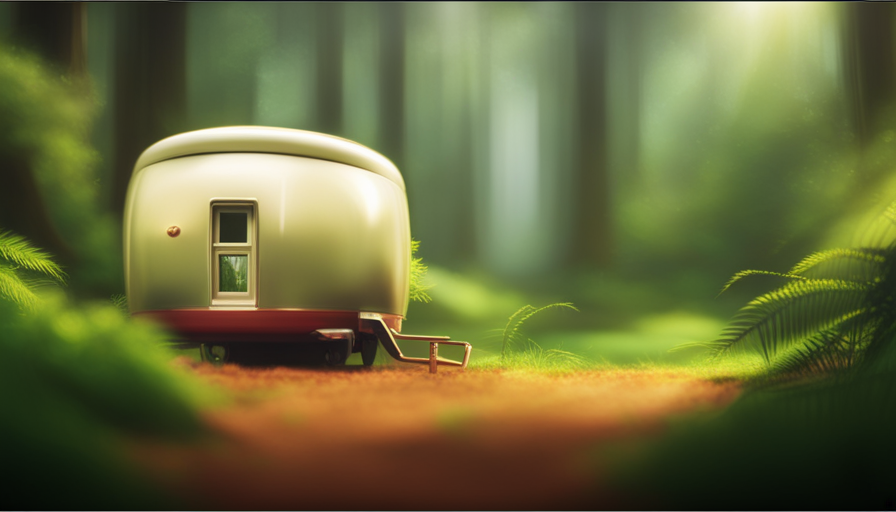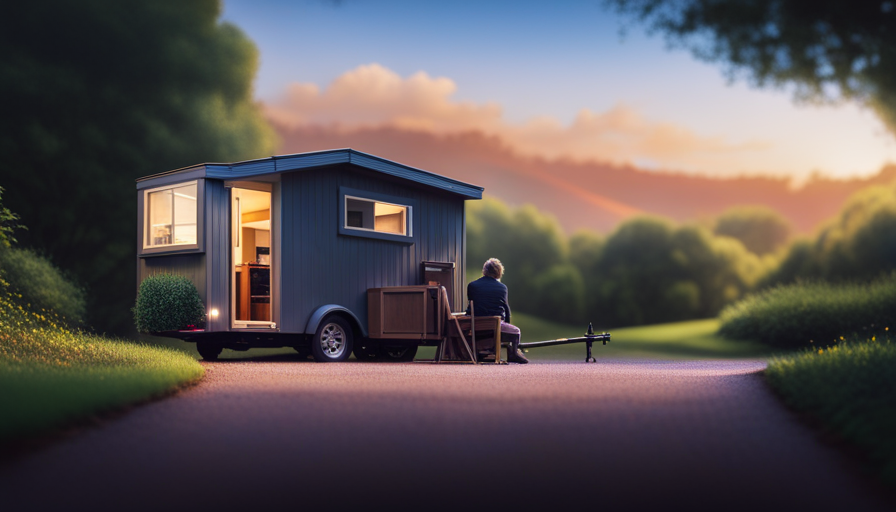In the vast world of homeownership, achieving your dream home can sometimes feel as challenging as catching a cloud. However, there is a hidden gem of optimism where innovative ideas blend with resourcefulness, transforming ordinary items into a comfortable, eco-friendly sanctuary.
Welcome to the world of tiny house construction, where the power of imagination and ingenuity reign supreme.
Just as a desert traveler relies on their survival skills to build a shelter using only what nature provides, so too can we harness the resources around us to construct our own tiny abode – and best of all, for free. By tapping into the vast network of discarded materials, community support, and our own DIY spirit, we can embark on a journey towards affordable, eco-friendly living.
In this article, I will guide you through the steps of building a tiny house for free, from finding the right materials to incorporating sustainable energy sources. So let’s dive in and discover the secrets of this enchanting world, where the possibilities are as vast as the desert sky.
Key Takeaways
- Free building materials can be found online and at local construction sites and salvage yards.
- Repurposing and recycling items can save money and reduce waste.
- Community resources and workshops offer knowledge, tools, and materials for building a tiny house.
- Consider alternative energy sources like solar power and wind energy to reduce reliance on traditional power grids.
Find Free Building Materials
Now it’s time to hunt down some free materials to bring your tiny house dreams to life! Finding free building materials is essential when you’re on a tight budget.
One great way to acquire these materials is to repurpose and recycle items. Start by checking online platforms like Craigslist or Freecycle, where people often give away unused construction materials.
You can also visit local construction sites and ask if they have any leftover materials they’re willing to part with. Another option is to explore your community for salvage yards or recycling centers that offer free or low-cost building materials. These places often have a variety of items such as doors, windows, lumber, and even insulation that can be repurposed for your tiny house.
Be sure to inspect the materials carefully to ensure they are in good condition and suitable for your project. Remember, one person’s trash can be another person’s treasure! By utilizing recycled and repurposed items, you not only save money but also contribute to reducing waste and preserving the environment.
Now, let’s delve into how to make the most of these materials in the subsequent section.
Utilize Recycled and Repurposed Items
Using your creativity and a touch of resourcefulness, transform forgotten treasures into the heartwarming pieces that’ll bring your dream sanctuary to life. Repurposing creativity is the key to building a tiny house for free.
One great way to find materials is by exploring thrift stores. These stores are a treasure trove of hidden gems just waiting to be repurposed. Look for items like old doors, windows, and furniture that can be transformed into functional and stylish elements for your tiny house. With a little bit of imagination and some DIY skills, you can turn these thrift store treasures into unique pieces that add character to your tiny house.
Another way to utilize recycled and repurposed items is by salvaging materials from construction sites or demolition projects. Many times, construction crews are happy to give away or sell materials they no longer need, saving them from going to waste. You can find everything from lumber and bricks to plumbing fixtures and lighting fixtures. By repurposing these materials, not only are you saving money, but you’re also reducing waste and giving new life to items that would’ve otherwise ended up in a landfill.
Incorporating repurposed materials into your tiny house not only adds charm and character but also helps to reduce the overall cost of your project. By thinking outside the box and getting creative with your resources, you can build a beautiful and sustainable tiny house without breaking the bank.
So, let’s move on to the next step and take advantage of community resources and workshops to further enhance your project.
Take Advantage of Community Resources and Workshops
Explore the incredible opportunities offered by community resources and workshops to maximize your creativity and save money on your dream sanctuary. By taking advantage of community collaborations and local government support, you can gain access to a wealth of knowledge, tools, and materials that will help you build your tiny house for free.
One way to tap into community resources is by joining local workshops and classes focused on tiny house construction. These workshops are often hosted by experienced builders and enthusiasts who are passionate about sharing their knowledge. You can learn valuable skills such as framing, plumbing, electrical work, and insulation installation. Additionally, these workshops provide a platform for networking and connecting with like-minded individuals who can offer guidance and support throughout your tiny house journey.
Another avenue to explore is community collaborations. Many cities and towns have initiatives that promote sustainable living and affordable housing solutions, including tiny houses. These programs often provide grants, subsidies, or access to discounted or free materials for those interested in building a tiny house. By partnering with these programs, you can significantly reduce the cost of your project while contributing to the community’s goals.
Transitioning into the subsequent section about learning basic carpentry skills, these community resources and workshops are an excellent starting point for acquiring the necessary knowledge and expertise to tackle the construction of your tiny house.
Learn Basic Carpentry Skills
Take advantage of local workshops and classes focused on carpentry to gain the skills you need to turn your dream of a cozy retreat into a reality, just like a rough piece of wood can be transformed into a beautifully crafted piece of furniture with the right tools and knowledge.
These workshops provide a great opportunity to learn woodworking techniques and master carpentry skills, which are essential for building your own tiny house.
In these workshops, you’ll learn the basics of carpentry, such as how to use and maintain tools, measure and cut materials accurately, and assemble structures safely and securely. You’ll also learn about different types of wood and their characteristics, as well as various joinery techniques that’ll enable you to create strong and durable connections between the different components of your tiny house.
By participating in these workshops, you’ll not only acquire the necessary skills but also gain confidence in your ability to build a tiny house from scratch. The knowledge and experience you gain will empower you to make informed decisions when it comes to the design and construction of your tiny house.
With your newfound carpentry skills, you’ll be ready to move on to the next step: planning and designing your tiny house layout.
Plan and Design Your Tiny House Layout
Once you’ve honed your carpentry skills, envision the layout of your cozy retreat, crafting a space that perfectly suits your needs and desires.
Room organization is key when it comes to designing a tiny house. Start by considering the essential rooms you’ll need, such as a kitchen, bathroom, living area, and bedroom. Think about how you can maximize the functionality of each space by incorporating clever storage solutions, multi-purpose furniture, and utilizing vertical space.
When planning your layout, take into account the flow of movement within the house. Ensure that there’s enough space to comfortably move around and that the layout allows for natural light to enter the different areas. Consider the placement of windows and doors to optimize views and create a sense of openness.
Interior decoration plays a vital role in making your tiny house feel cozy and inviting. Choose a color scheme that reflects your personal style and creates a cohesive look throughout the space. Opt for furniture and decor pieces that are appropriately sized for the tiny house, avoiding anything too large or bulky that may overwhelm the space.
Transition into the next section about creating a budget and sticking to it by considering the cost of materials and furnishings as you plan and design your layout.
Create a Budget and Stick to It
To successfully create your dream tiny house, it’s crucial to establish a realistic budget and commit to it throughout the entire process. Stick to your budget by carefully planning and tracking your expenses.
Prioritize your needs and avoid unnecessary splurges. Start by making a list of essential features and materials required for your tiny house. Research and compare prices to find the best deals and discounts. Be resourceful to build a tiny house for free by utilizing recycled or salvaged materials. Look for local salvage yards, construction sites, or online platforms where people give away or sell used building materials at a fraction of the cost. Consider repurposing old furniture or finding low-cost alternatives.
Additionally, you can save money by doing some of the construction work yourself or enlisting the help of family and friends. Remember, building a tiny house on a tight budget requires creativity and flexibility. By sticking to your budget, prioritizing your needs, and being resourceful, you can create a beautiful tiny house without breaking the bank.
Transitioning into the subsequent section about alternative energy sources, it’s important to consider sustainable options for powering your tiny house.
Consider Alternative Energy Sources for Sustainable Living
After creating a budget and sticking to it, it’s important to consider alternative energy sources for sustainable living when building a tiny house. One of the most popular options is solar power. Solar panels can be installed on the roof of the tiny house to harness the energy from the sun and convert it into usable electricity. This renewable energy source not only reduces reliance on traditional power grids but also helps minimize the environmental impact of the house.
Another alternative energy source to consider is wind energy. Installing a small wind turbine near the tiny house can generate electricity from the wind. This can be especially beneficial in areas with consistent wind patterns. By utilizing both solar power and wind energy, a tiny house can achieve a high level of self-sufficiency and reduce or eliminate monthly utility bills.
Incorporating these alternative energy sources into the design and construction of a tiny house requires careful planning and consideration. The placement of the solar panels and wind turbine should be optimized to maximize their efficiency. Additionally, the electrical systems of the tiny house need to be designed to accommodate the energy generated from these sources.
By incorporating solar power and wind energy into the design of a tiny house, homeowners can enjoy the benefits of sustainable living while minimizing their carbon footprint.
In the next section, we’ll explore how to incorporate space-saving and multi-functional furniture into the tiny house design.
Incorporate Space-Saving and Multi-Functional Furniture
When it comes to designing a tiny house, incorporating space-saving and multi-functional furniture is key to maximizing the limited space available. In order to make the most of every square inch, it’s important to consider space-saving hacks and creative storage solutions.
One effective space-saving hack is to utilize furniture with built-in storage compartments. For example, a bed with drawers underneath or a coffee table with hidden storage can provide additional space for storing belongings.
Another option is to invest in furniture that can be easily folded or collapsed when not in use. This allows for flexibility in the layout of the tiny house and frees up valuable floor space.
Additionally, incorporating multi-functional furniture can serve multiple purposes and save space. A sofa that can be transformed into a bed or a dining table that can double as a workspace are great examples of multi-functional furniture.
By carefully selecting and arranging furniture, it’s possible to optimize the functionality and livability of a tiny house. When seeking help from friends and family, their input can be valuable in determining the best furniture arrangements and maximizing the use of space.
Seek Help from Friends and Family
Why not enlist the help of your friends and family to make the most of your tiny space? When it comes to building a tiny house for free, getting creative and seeking assistance from your loved ones can go a long way.
Here are four ways you can involve your friends and family in your tiny house project:
-
Get creative: Brainstorm with your friends and family to come up with innovative ideas for your tiny house. Their fresh perspectives and creativity can help you optimize the limited space and make the most of every square inch.
-
Barter for materials: Instead of spending money on expensive building materials, consider bartering with friends or family members who may have unused items you can repurpose for your tiny house. This way, you can save money and reduce waste.
-
Ask for donations: Reach out to your network and ask if anyone has spare building materials or household items they no longer need. People are often willing to donate items they no longer use, especially if they know it will be put to good use in your tiny house.
-
Crowdfunding and local businesses support: Consider starting a crowdfunding campaign to raise funds for your tiny house project. Additionally, reach out to local businesses and explain your project. They may be willing to sponsor or donate materials to support your endeavor.
By involving your friends and family in your tiny house project, you not only benefit from their support and expertise but also create a sense of community around your build. So, embrace the DIY spirit and enjoy the journey of constructing your dream tiny house.
Embrace the DIY Spirit and Enjoy the Journey
Immerse yourself in the DIY spirit and savor every moment of the exciting journey towards creating your own charming, space-efficient haven. Building a tiny house is not just about the end result; it’s about enjoying the process and finding inspiration along the way.
To fully embrace the DIY spirit, take the time to research and gather ideas from various sources. Whether it’s browsing through magazines, visiting tiny house communities, or exploring online forums, finding inspiration will fuel your creativity and help you envision the perfect design for your tiny house.
One effective way to organize your ideas is by creating a table that outlines different aspects of your tiny house. Here’s an example:
| Aspect | Description | Inspiration |
|---|---|---|
| Layout | Optimize space utilization | Visit tiny house exhibitions |
| Materials | Sustainable and cost-effective options | Explore salvage yards |
| Interior Design | Clever storage solutions and multipurpose furniture | Browse tiny house blogs |
| Utilities | Off-grid options for water and electricity | Research alternative energy sources |
| Exterior | Creative use of materials and aesthetics | Take photos of architectural details |
By incorporating this table into your planning process, you can create a rhythm and flow in your tiny house construction journey. It will serve as a visual reminder of your goals while keeping you motivated and inspired throughout the project.
Remember, building a tiny house is not just about the destination but also about the joy of the journey. Embrace the DIY spirit, relish in the process, and let your creativity soar as you create your very own cozy sanctuary.
Frequently Asked Questions
Can I build a tiny house for free without using any recycled or repurposed materials?
Yes, it is possible to build a tiny house for free without using recycled or repurposed materials. For example, by utilizing free building materials from construction sites or by bartering skills for materials.
What are some alternative energy sources I can consider for my tiny house?
For my tiny house, I can consider using solar power and wind power as alternative energy sources. Solar panels can generate electricity from sunlight, while wind turbines can harness wind energy to produce power.
Are there any tips on how to find free building materials other than the ones mentioned in the article?
To find free building materials for a tiny house, explore local classified ads, online forums, and social media groups dedicated to recycling and repurposing. Be creative and think outside the box when repurposing materials, such as using pallets for flooring or reclaimed windows for natural lighting.
Can I build a tiny house without any basic carpentry skills?
Yes, it is possible to build a tiny house without basic carpentry skills. Alternative construction methods like using pre-fabricated kits or hiring a professional carpenter can make the process easier and ensure a high-quality build.
How do I incorporate space-saving and multi-functional furniture in my tiny house design?
To incorporate space-saving and multi-functional furniture in my tiny house design, I will focus on space saving storage solutions such as built-in shelves and hidden compartments. Additionally, I will utilize creative and efficient room dividers like sliding doors and folding screens.
Conclusion
In conclusion, building a tiny house for free requires resourcefulness, creativity, and a willingness to embrace the DIY spirit. By finding free building materials, utilizing recycled items, and taking advantage of community resources, one can significantly reduce the cost of building a tiny house.
Learning basic carpentry skills and incorporating space-saving furniture are also essential in maximizing the limited space. Additionally, considering alternative energy sources promotes sustainable living.
As the saying goes, "Where there’s a will, there’s a way," and with determination and ingenuity, anyone can achieve their dream of building a tiny house without breaking the bank.
Hi, I’m Emma. I’m the Editor in Chief of Tiny House 43, a blog all about tiny houses. While tree houses are often associated with childhood, they can be the perfect adult retreat. They offer a cozy space to relax and unwind, surrounded by nature. And since they’re typically built on stilts or raised platforms, they offer stunning views that traditional homes simply can’t match. If you’re looking for a unique and romantic getaway, a tree house tiny house might just be the perfect option.
